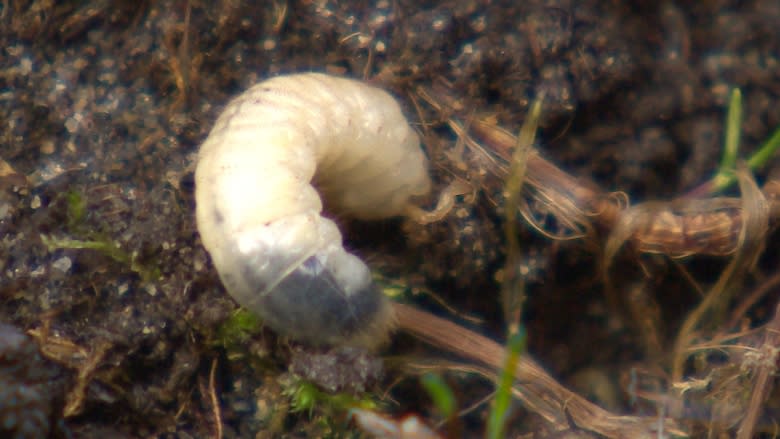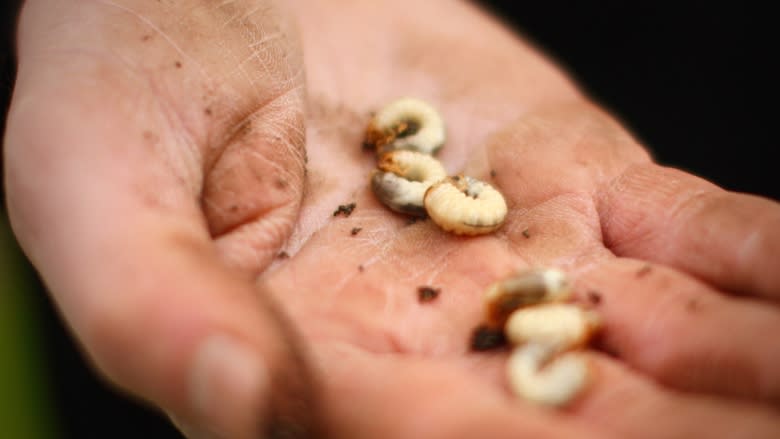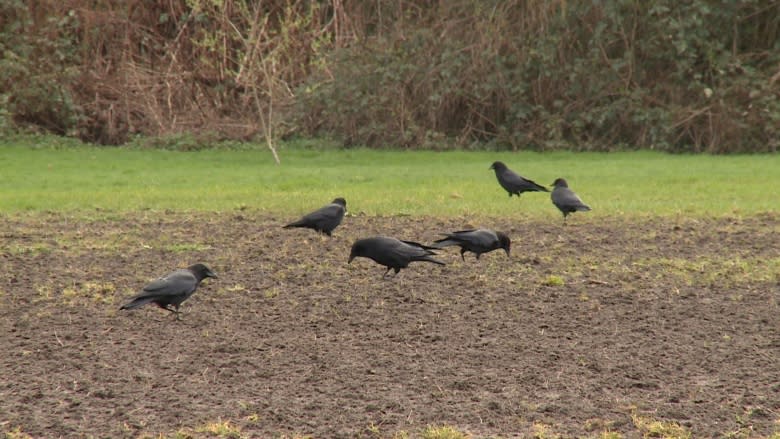Voracious grub and its predators destroy Fredericton lawns and sports fields
A tiny white grub known as the European chafer beetle is becoming a real nuisance for property owners and recreational clubs — killing lawns and sports fields across the capital city.
At least five of the city's 21 baseball fields have been destroyed and two other fields have sustained moderate damage.
This isn't good news for local athletes trying to play on torn-up fields this summer.
- Fredericton lawns at the mercy of invasive beetle
- Mild winter means chafer beetle is back with a vengeance
"It's very hard to field the ball when it's kind of bouncing all over the place, especially in the outfield when there's a ground ball hit toward you," said Paul Hornibrook, director-at-large for the Fredericton Minor League Baseball Association.
Hornibrook said turned-up sod caused by the predators of the small insects can also cause injuries for players.
"Every year there seems to be something that you have to try to deal with," he said. "This year we've got fields turned up."
Once a mystery bug
So what is the European chafer beetle, exactly?
The insect is a small white grub, formed in the shape of a C. Eventually it turns into a beetle that flies away, then returns in summer to lay eggs.
The grub causes extensive damage to lawns and sports fields across the city by eating root systems of grass and other plants. Their presence is obvious where there is loose, spongy or dead grass.
But in addition to the damage they do as they tunnel and eat underground, the grubs are food for birds, skunks and other small animals, which dig up lawns to get at them.
"You kind of get hit on both fronts with little benefit," Mike LaCroix, foreman of horticulture with the city's parks and trees division.
In a Facebook post this week, Mayor Mike O'Brien said the damage to sports fields occurred between mid-April and May.
Crews were dispatched across the city to re-establish the grass at each field.
"We are top dressing with compost and soil and seeding with a grass seed mix," said Michael Baldwin, a city spokesperson.
Beetle's a 'game changer'
LaCroix described this year's infestation as a "game changer."
"We got hit really hard in comparison to last year," LaCroix said in an interview with Information Morning Fredericton.
"It's eating up a lot of my resources … this is above and beyond."
The grub population has grown exponentially, and the city has lost a lot of turf.
But it's not just a problem in Fredericton. The European chafer beetle has been a nuisance across Canada, starting in Vancouver back in 2001.
Good news and bad news
Since most of the damage has already happened, Chris Maund, a provincial government specialist from integrated pest management, said lawn maintenance crews and homeowners can start thinking about re-seeding their lawns.
"Most people would tend to wait until almost all of the damage is done and then re-seed or re-sod," he said.
"You want to do that before the adults reappear and lay eggs and you would want to do that sometime in June."
He said homeowners would want a healthy lawn but the likelihood of the beetle returning is still high.
According to some research in the U.S., Maund said, there is an 80 per cent chance a treated area will be reinfested.
The battle continues
Meanwhile, city staff are still trying to combat the insect and clean up fields so they can have a proper playing surface for athletes this summer.
"It's an ongoing battle and we're going to have to step up the game and apply every practice we can to get those turf fields back to where they need to be," LaCroix said.
Nematodes should be applied to affected lawns and fields in late July and early August, once the insects come out of the ground and start to mate.
"Once you see those exoskeletons of the beetle lying on the ground, you know they've gone back in," he said. "That is the optimal time to spray your nematodes."
He said it's also important to keep grass a bit longer to combat pests and weeds.
"If there's eggs still in the soil and they get missed, you're back to square one," LaCroix said.
Back on the ball field
With a growing interest in baseball, Hornibrook said it's important to teach kids how to properly use the fields and be a bit more careful in grub-afflicted areas while playing the game.
"It's like trying to go to a hockey game and there's a snowstorm outside," he said.
"You've got to figure out the conditions and make up your mind on how you're going to approach it."





